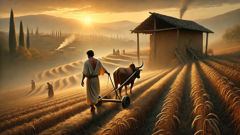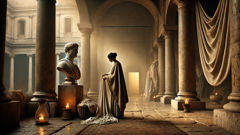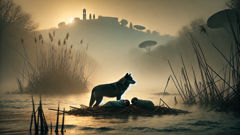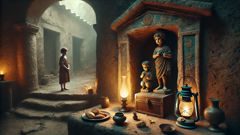Introduction
Along the lanes of west Cork, through the peatlands and hedgerows of Munster, and in the shadowed folds of Ulster's bogs, the old people spoke of a rider who came before the last knock at the door. They said he wore no head, and yet his voice could call a name like wind through reeds. Children learned to hush when the wind took on the timbre of a man's laughter, for laughter could be the Dullahan testing the locks of the world. This is not the gaudy ghost of later ballads, nor the theatrical specter of a stage play. The Dullahan belongs to nights when lamps gutter and animals listen. He travels without lantern or torch, but the eyes of his carried head burn like coal and the mouth is a pale crescent of teeth. The horse beneath him is a creature of midnight, a hoofbeat that does not echo the same way twice. People did not merely fear him; they respected the geography of his visitations, naming hedges he would not cross and roads where the fog kept its distance. The stories are many and contradictory, as good folklore should be: some claim the Dullahan was once a rider wronged by his kin, others insist he is an emissary of a fairy court that uses his body as a bookkeeping ledger of mortality. In this retelling, listen for the voices of those who met him, the rituals that bought time and mercy, and the uneasy consolation that the Dullahan embodies. He is at once omen and agent, a boundary figure that marks the fragile edge between life and what comes after, and in hearing his tale we walk that boundary by lantern light, feeling the cold press against our necks.
Origins and Old Stories: How the Dullahan Came to Be
The origins of the Dullahan rest in the braided tangle of Irish belief, where a single image can mean iron, water, law, or the shifting line of the farmland. Some tales say the first Dullahan was not born of malice but of an old contract breached. A chieftain who ordered his steward to be killed and buried in a crossroad found himself stalked by a rider carrying a head that whispered his name until his blood dried in the soil. Others point to a more ancient current: the changeling business of the sidhe, fair folk who prized sharp rituals and harder bargains. To them, taking a head is bookkeeping. The head holds the last breath, the tally of kin and debt; to carry it is to carry the bill. In certain counties, the Dullahan was a grim taxman for otherworldly courts, summoned when a lineage failed to pay the dues that kept the land in balance.
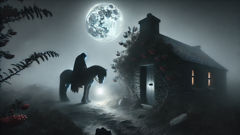
These origin stories are useful for a culture that keeps its memory close. They allow villagers to name the cause of grief and to believe that actions have consequences beyond the visible. In the story told in a farmhouse near Lough Derg, a woman recalled how the Dullahan appeared the night her youngest son took his coat and walked out, determined to fight a quarrel that had nothing to do with him. The headless rider rode up the lane, stopped beneath the sycamore, and put his head in both hands as though reading from a ledger. He spoke the name of the son in such a clear voice that the woman thought she might go mad. She laid a piece of black bread outside the door and chanted a line of verse she had heard from her grandmother. The Dullahan set the head in the crook of his arm and looked at the bread. It was not hunger he considered, it was respect for the old ways. He moved on, as if the charm had bidded him elsewhere. The son returned the next day with frost on his boots, as if death had grazed him and decided to step away.
Different regions offered different manners of encounter. In some pockets of Connacht, he was said to be more violent: if the Dullahan raised the head and faced the house, whoever the mouth named would breathe out his last breath within a fortnight. Another telling speaks of the head casting sunlight in a strange way, a radiance that made horses neigh and dogs go blind. To avoid naming names, villagers would tie sprigs of rowan to the latch or smear iron filings in the threshold, because iron and rowan both stand guard in older thinking. Yet in other communities he was almost bureaucratic, a creature of ritual and form. He would ride to a house and count those inside with the flicker of his mouth; if one was missing and a line of verse was broken, the rider left a token, a mark on the lintel, or an audible sigh that meant it would be the turn of that family in the next year.
The Dullahan's head itself seems to be an artifact of mythic bookkeeping. It is sometimes bald, sometimes crowned with a coil of hair damp as though from a wet grave. Its eyes can be empty or ablaze, and its mouth may utter a single line—an address, a question, a name. When it speaks a name, the name is often the name the dead will take on the road to the otherworld. But other stories transform the moment into something filmy and strange. In one telling a young midwife came upon the rider standing beside a hedge where a birth had taken place. The Dullahan set the head upon the newborn's clean sheet and read out two names, a life and an account. The midwife, terrified, whispered a different name, a trick learned from a grandmother who remembered old bargains. The Dullahan laughed an empty laugh and left, but later the midwife learned the child survived only by bearing the burden of that secret.
Why does the Dullahan carry his head? Some say it is punishment, some say it is necessity. The head is a ledger; living without it, the rider must keep it close, for the head is where debts are kept. He travels between hedgerows not to frighten but to make the round of accounts. Folklorists have argued that the image is an amalgam of older Indo-European motifs of the severed head as a symbol of power, fertility, or curse. The head was a place of name, soul, and voice. To display it is to display jurisdiction over fate. The Dullahan reproduces a cosmic bookkeeping: each time he crosses a road and halts, a life is tallied and a name is marked. Yet the human response is rarely passive. Families developed liturgies of warding, small superstitions and verbal acts that amounted to social insurance against the absolute finality the rider represents. You will read later how a rusty nail, a blackened shoe, a pinch of salt, or a line of ancestral verse could detain him for days, or in one instance, change his mind.
There are other elements tied to the rider that reveal his kinship with the landscape. He is not entirely immune to boundary markers, and in many tales he cannot cross certain lines. Wary travelers learned to place a saddlecloth or a child s swaddling inside a ring of salt to make it unattractive to him, since salt is a preservative that confuses the accounting. In certain districts, church bells could scatter him, or at least anneal his appetite for specific names. Yet he is not strictly religious or anti religious; the Dullahan respects ritual more than doctrine. A chanter of psalms once forced a rider to pause until the verse ended, at which time the Dullahan shook his head and left, as though he had been made to listen to an ordinance of tallying but found nothing to add. In net, the origin strands show a composite being: part punitive revenant, part fairy agent, part cosmic clerk. He carries an image of inevitability, and yet he is not without purchase. The old lore teaches that to live under him is to learn an economy of caution: keep your accounts with neighbors, respect the hedges, and remember the naming rituals that once tethered a life to its place.
The Dullahan also appears in the margins of historical records and travelers accounts, where antiquarians recorded stray glimpses and the kind of anecdote that survives because communities preferred to remember their defiance. An 18th century scribe, translating older oral material, wrote that a Dullahan was seen riding the bog road outside a manor, and the manor woman placed fresh shoes on the sill to confuse the rider. The rider studied the shoes as if counting soles, then moved on. Whether the accounts are literal truth matters less than their social function: they regulate behavior. The fear of the rider becomes a way to teach children to come home before night, to mind the neighbors, to leave a light for wayfarers. Within every telling is a careful negotiation between fatalism and the rituals of refusal. The Dullahan is an image by which communities measure their courage and their ability to hold off the dark for one more night.
Encounters, Rituals, and Meaning: Meetings with the Rider
To meet the Dullahan is to experience a particular combination of terror and protocol. In villages where the stories were believed as keenly as weather forecasts, people developed specific practices to respond when he was sighted. The patterns of action are consistent: do not look directly at his eyes if you can help it, do not run in the lanes since flight draws attention, and never, under any circumstances, call a name back at him. Calling the name is equivalent to signing the receipt. Instead, you make small offerings, perform a protective chant, or wait until he passes. These responses come from a long cultural memory of bargaining with forces larger than oneself.

One of the most recorded rituals involves the humble horse bridle. A farmer of County Clare once told how his daughter stepped into the lane at dusk to fetch a lost shoe and found the Dullahan staring where the lane turned. She did not scream. Instead she placed her palm on the bridle and recited a brief, meaningless rhyme her aunt had taught her. The rider paused, like a clock checking its weight, and then drew his head closer as if to answer. His mouth moved but made no sound that reached her ears. When he finally rode away the family counted three crows and sealed the door with a strip of iron. That strip remained for three winters thereafter as a ward, a reminder that small acts of recognition and timely offerings could extend a life by days or years.
In another telling from the Boyne valley, a man engaged the Dullahan in what might be called polite argument. The rider had come for a young mother who had defied a local betrothal and given birth to a child by a man from another clan. The father stood in the yard and faced the Dullahan, offering a sack of oats, a measure of whiskey, and a verse of lamentation. The Dullahan tilted the carried head and listened. He then set the head on the ground between them and winked with its left eye, a small concession. The man bargained until dawn, and in exchange the rider took another's name rather than the mother's. Community memory preserved the man s shrewdness as a cautionary tale: bargains with the otherworld can buy time but always cost something.
Children learned to tease danger rather than ignore it. A group of boys from a Kerry village once tried to trap the rider by driving their cows to the lane and leaving a child's cap on the fencepost. They thought the cap would serve as a talisman, tricking the rider into counting a name that was not there. That night the Dullahan stopped, leaned his head close to the cap, and then laughed with a hollow echo. He did not take the cap, but he left a dark mark on the post that smelled of bog, the kind of stain that would not wash out. The boys' prank became a lesson: certain playfulness only invites darker examination, and the Dullahan is something that tests the border between mischief and fate.
In the world of midwives and grave diggers, the Dullahan had a more complicated role. Midwives told of a rider who arrived at the bed of a dying woman and placed the head upon a chair, reading the woman's name like a ledger. He counted the breaths she had borrowed, then looked at the midwife and tipped his head in acknowledgement of the services rendered. Grave diggers, who spent their nights measuring the forgiveness of the ground, swore that the Dullahan sometimes led a procession of phantom horses to the very plot where a body would be turned. They also insisted that the rider would not enter a hallowed ground unbidden; his jurisdiction was often the threshold, the road that connected one place to the next, not the churchyard itself.
Wards and counter rituals were abundant and varied. Iron remained the most trusted repellent, its cold matter believed to blunt fair folk power. Rowan branches over thresholds mark another constant. Salt in the hearth, a smeared shoe upon the sill, or a scrap of the dead person's cloth kept in a pocket could divert attention or confuse the rider long enough for a family to perform last-sacrifice rites. The ritual of naming and renaming is especially potent: if someone suspected they were marked, they might assume an alias for a day, sleep with their head turned away from the door, or ask an elder to recite a protective stanza to rearrange the ledger. In many cases these rituals did not change destiny so much as restore human dignity and order in the face of unnerving powers.
Why invest so much labor in warding? Because the Dullahan is an embodiment of boundary. He forces recognition of the fragile systems that tether community and mortality. People invested in ritual because their rituals were social glue: they gave families a sense of agency, a way to act when fate seemed arbitrary. Warding is less an illusion of control than a rehearsal of belonging. When neighbors gather to place a sprig of rowan, they also witness one another s care, reasserting the bonds that define a village. Even when the Dullahan takes a name, the community remains intact because it participated in the ritual of resistance.
There are also instances in which the rider appears to be less a malevolent collector and more an executor of a cosmic census. In some stories he does not cause death; he is a herald. His arrival announces the passing, either imminent or already occurred but unreported. A woman in rural Meath recounted a winter when the Dullahan visited nightly for a week, placing his head on the table and whispering the names of farm animals as if the balance of barns must be inspected. At the week's end the family discovered a plague of sickness among the animals; the Dullahan had been a precursor. Such tales suggest the rider is not merely a personal antagonist but a systemic agent, moving through places that have become unbalanced, calling the ledger to account. Whether omen or agent, the Dullahan forces people to remember that human life is entangled with landscape, law, and memory. The lore around him is then both survival manual and moral argument: tend the hedges, keep your stitches tight, and speak the names of the dead with care.
Conclusion
Across generations the Dullahan remained an image flexible enough to inhabit many roles: punisher, herald, courtier, and test of household discipline. Communities kept him at a distance with iron and verse, with small offerings and the stubborn repetition of old names. But beyond the supernatural details lies a human reason the story endures: it gives shape to grief, and it teaches a way to hold one another in the dark. Folklore transforms the unknowable into practice. When an elder tells a child to be home before the lane grows thin with moonlight, the Dullahan is the story driving home the value of simple prudence. When a mother ties rowan to a lintel, she participates in a ritual that is both protection and expression of care. And when a traveler reads the hedgerow and recognizes the places the rider avoids, that reading is an act of belonging. The Dullahan presides over an economy of endings, and in learning its rules communities found a language with which to negotiate loss. He is not merely a brute harbinger; he is an agent who enforces consequences and offers, in his dreadful way, a script for responding to mortality. To retell his tale is to keep practicing the rituals that tether life to place. In doing so, we honor the ancestors who taught those rituals and we remind ourselves that stories, like rowan sprigs and iron nails, are tools against an indifferent dark.








